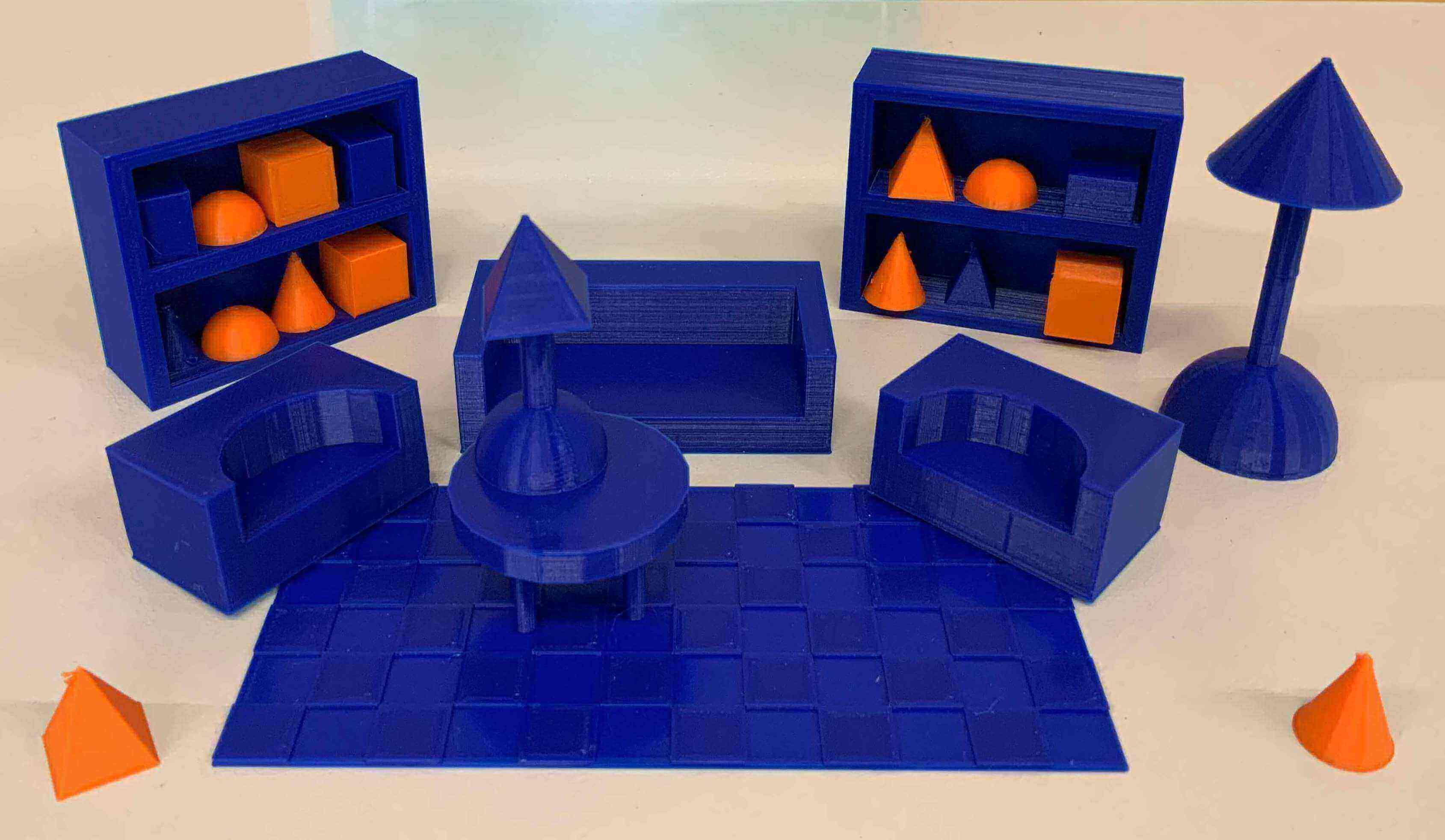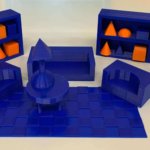
Technichal Specifications
How to use this exercise?
The model is used to promote spatial imagination and geometric knowledge when calculating spatial figures.
1. In the 3D-printed furniture of the living room, the pupils first have to recognize the composite bodies. They calculate the individual volumes of the furniture (= assembled body). The individual dimensions are either read using the TINKERCAD software or measured with a Vernier calliper using the 3D-printed model. This is how the volume of the entire furniture of the living room is calculated.
2. The second major part of this exercise is to create a new living room furniture using the 3D software TINKERCAD.
Number of pieces of this exercise
22
General description
The living room Gauss model consists of a total of 24 pieces of furniture or decorative items, each of which represents a composite geometric body. The miniature objects have different levels of difficulty. For example, the volumes of the decorative items or the sofa can be calculated more easily than those of the lamps, which, due to the more complex designs, require a more complex calculation.
The 180-minute teaching phase can be divided into five phases.
1. Calculation of the total volume of the “living room Gauss” model
• The pupils should first recognize the assembled geometric bodies and then be able to calculate their volumes using a formula collection.
• The students read the dimensions within the various files in the 3D software TINKERCAD; alternatively, the dimensions can also be measured on the 3D-printed miniature furniture by using a Vernier calliper.
• Tools: formula collection, learning video on how to use the TINKERCAD software (e.g. how do I read the dimensions of the model? How do I ungroup the models so that I can see all dimensions?)
2. Conversion of the volume into weight and calculation of the costs
• The pupils calculate the total weight of the living room model in the various material types (gold, silver, bronze & wood) and units (kg or g) using the rule of three calculation.
• Then the total costs of the living room model are calculated for each material type.
• Tools: calculator and material & cost table:

3. Volume calculation of the special “Sphere” armchair
• The stutends examine the 3D-printed object and discuss within the group which composite geometrical bodies the piece of furniture consists of.
• The students recognize that the volume calculation of this armchair is not possible by using the current mathematical knowledge.
4. Creation of an own living room model for the architect’s office “Geometrie”
• The pupils now create their own living room model using the 3D printing software TINKERCAD.
5. Presentation of the living room models and selection of the winning group
• The students present their living room model to the class. The other students evaluate the models.
• Furthermore, attention is paid to the printability of the models.
• The living room model which has the smallest volume is printed.
• The pupils improve possible construction errors regarding the printability of the winning model.
Additional Material
Models used:
License Info
Attribution 4.0 International (CC BY 4.0) https://creativecommons.org/licenses/by/4.0/You are free to:
Share — copy and redistribute the material in any medium or format
Adapt — remix, transform, and build upon the material
for any purpose, even commercially.
Under the following terms:
Attribution — You must give appropriate credit, provide a link to the license, and indicate if changes were made. You may do so in any reasonable manner, but not in any way that suggests the licensor endorses you or your use.
No additional restrictions — You may not apply legal terms or technological measures that legally restrict others from doing anything the license permits.
Learning Specifications
How can the model be used in class?
After all geometry bodies were discussed individually in the classroom, the entire curriculum unit “Geometry” within the final topic “Compound bodies” should be repeated and applied.
Phase I: The aim of using the specified living room model “Living room Gauss” is that the students first recognize different geometrical bodies in the 3D-printed pieces of furniture. The spatial representation of the students is to be improved by the haptic representation, since this is often missing when you only use sketches and drawings.
Phase II: Furthermore, the difference between volume and weight can be better illustrated by using the 3D models.
Phase III: With the help of the printed model of the spherical armchair, the students become aware of the limits of the volume calculation within the thematic unit “geometry”. Awareness of possible and not possible composite bodies in the context of volume calculation is particularly important for the following phase.
Phase IV: By creating your own living room model in this phase, the task is reversed. With the help of the 3D printing software TINKERCAD, the pupils can create their own composite bodies, which is otherwise difficult for the pupils (or only with paper and pen) due to a lack of imagination and drawing talent.
Phases V & VI: These final phases are intended to reveal both mathematical errors and possible design errors when working with the software. Here too, communication and the three-dimensional representation promote both spatial thinking and the mathematical perspective.
What benefits can its use have?
• Improvement of the spatial imagination due to the three-dimensional representation with the help of the software TINKERCAD (also: change of perspective) and due to the haptic 3D-printed models.
• New types of tasks are now more feasible. By the use of a 3D software like TINKERCAD, the student can produce composite bodies by himself and not only specified by the teacher.
• There are no limits to the creative use of volume calculation or formulas.
• The use of the 3D models or the software contributes to the motivation in mathematics lessons.
• In particular through phase IV, in which an own living room model is created, an internally differentiated lesson is carried out. So it can be assumed that students with higher learning skills will construct extravagant pieces of furniture.
• Promotion of social skills through the student-centered longer work phases and the idea of competition.
Can it be used in other subjects?
Computer science
Manufacturing engineering
